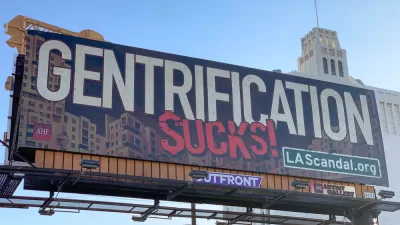Sharon McNary reports on a proposed development in the Chinatown neighborhood of Los Angeles that predates, and could thus avoid, the guidelines put forward by one of the most progressive plans in the city—the Cornfield Arroyo Specific Plan.
Sharon McNary reports on the project proposal for "College Station" mixed-use development slated for five acres of vacant land just east of the Chinatown station of the Gold Line light rail line connecting Union Station with Pasadena. College Station, would include two towers with up to 685 apartments, ground-level retail and restaurants, rooftop pools, and a pedestrian plaza. "They would become the tallest buildings in Chinatown," according to McNary.
The project's controversy, however, comes from its out of scale reference to the 2013 Cornfield Arroyo Specific Plan, which is often referred to by planners as an example of a new era in planning, mostly due to its lack of parking requirements.
"If built according to the Cornfields plan, the College Station parcel would be mostly commercial, retail and light industrial, with at most 200 homes. About 20 of the homes would need to be affordable to residents of the area..." Of the 685 units proposed by the developer, 100 would be for senior housing.
So why the discrepancy between plan and project? According to the McNary, the developer "will not be held to the Cornfields plan standards…because the company filed its application and a zone change request for the College Station project in 2012, a year before the Cornfields plan was approved."
As described by McNary, the controversy comes back to that problem of how developments can often catch neighborhoods by surprise, even when a plan guiding the vision of the neighborhood is already in place. "When it was adopted in 2013, a Los Angeles Times editorial called it a 'smart development' plan that should become a model for the city, one that would give residents of the area around Chinatown's Cornfields park a sense of certainty about future building plans."
FULL STORY: Mega-project may skirt Chinatown 'smart' development rules

Study: Maui’s Plan to Convert Vacation Rentals to Long-Term Housing Could Cause Nearly $1 Billion Economic Loss
The plan would reduce visitor accommodation by 25,% resulting in 1,900 jobs lost.

North Texas Transit Leaders Tout Benefits of TOD for Growing Region
At a summit focused on transit-oriented development, policymakers discussed how North Texas’ expanded light rail system can serve as a tool for economic growth.

Using Old Oil and Gas Wells for Green Energy Storage
Penn State researchers have found that repurposing abandoned oil and gas wells for geothermal-assisted compressed-air energy storage can boost efficiency, reduce environmental risks, and support clean energy and job transitions.

Santa Barbara Could Build Housing on County Land
County supervisors moved forward a proposal to build workforce housing on two county-owned parcels.

San Mateo Formally Opposes Freeway Project
The city council will send a letter to Caltrans urging the agency to reconsider a plan to expand the 101 through the city of San Mateo.

A Bronx Community Fights to Have its Voice Heard
After organizing and giving input for decades, the community around the Kingsbridge Armory might actually see it redeveloped — and they want to continue to have a say in how it goes.
Urban Design for Planners 1: Software Tools
This six-course series explores essential urban design concepts using open source software and equips planners with the tools they need to participate fully in the urban design process.
Planning for Universal Design
Learn the tools for implementing Universal Design in planning regulations.
Ascent Environmental
Borough of Carlisle
Institute for Housing and Urban Development Studies (IHS)
City of Grandview
Harvard GSD Executive Education
Toledo-Lucas County Plan Commissions
Salt Lake City
NYU Wagner Graduate School of Public Service




























